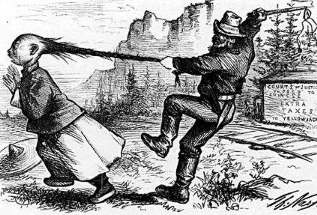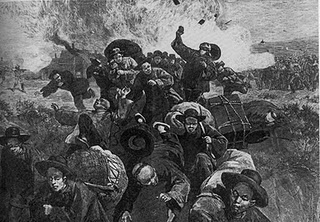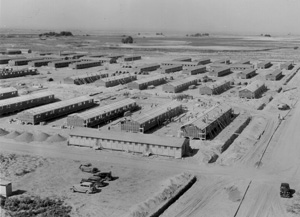Yellowface!
Legal Discrimination and Violence Against Asian
Immigrants
Between 1850 and 1930, about one million Asians from China, Japan, Korea, the Philippines, and
India came to the United States. But by the second half of the 19th
Century a backlash had developed; Asian immigrants and the assimilation of Asians
into society was said to pose, "the greatest threat to Western
civilization and the White Race" and increasingly restrictive laws
were passed; first to keep Asians out of the skilled trades, then to restrict
further immigration, and later to end all Asian immigration.
The 1850 Foreign Miners Tax placed a $20 a month tax on all miners of foreign origin in California. The 1852 version of the law placed a $3 a month tax exclusively for Chinese laborers. Taxes for Chinese steadily increased with ever harsher bills passing the California Legislature and signed into law by then California Governor Bigler. One law passed by the State Legislature and signed by the Governor created a $50 tax per head for Chinese entering Californian ports that was to be paid within three days.
The California Supreme Court later ruled the law unconstitutional.

Miners Tax of 1850 The Anti-Coolie Act was enacted by the state of California in
1862. Its proper title is "An act to protect free white labor against competition with Chinese coolie labor, and to discourage the immigration of the Chinese into the State of California." It was designed to protect native residents of the state from competition in the labor market from Chinese immigrant manual laborers. It aimed to discourage Chinese citizens from immigrating to California by placing a per capita tax on all Chinese laborers in the state of California.
The "police tax" required a monthly work permit for any worker over the age of 18 of the "Mongolian Race." The act exempted Chinese workers engaged in the production or manufacture of sugar, rice, coffee or tea. When Chinese miners lost their jobs, they turned to the Central Pacific Railroad, which was desperate for workers.
About 12,000 Chinese worked to build the most difficult part of the transcontinental railroad in the Rocky Mountains. However, once the transcontinental railroad was completed in 1869,
the Chinese men were fired and not included in the celebrations. In fact, the were not
even allowed to ride on the railroad they built and had to walk back to San Francisco. Such mistreatment was only the beginning of a long history of an anti-Chinese movement that galvanized the West in the 1870s and 1880s,
during a devastating economic recession. Chinese men were stereotyped as degenerate heroin addicts whose presence encouraged prostitution, gambling, and other immoral activities.
In what becomes known as the Chinese Massacre of 1871, Chinese-occupied buildings
were ransacked and residents were attacked or robbed in Los Angeles'
Chinatown by an angry mob of over 500 Whites. The county coroner confirmed 19 Chinese deaths at the hands of the mob
and some estimates put the number of deaths at 84. In 1872, all ethnic Chinese
were barred from owning real estate or business licenses in California.
A number of other cities on the West Coast (including Seattle in 1886) experienced riots in which Whites attacked Asians and destroyed Chinese sections of town. The Seattle riot resulted in practically the entire Chinese population being rounded up and forcibly sent to San Francisco. Similar situations in other towns encouraged Chinese workers scattered throughout the West to relocate, leading to the growth of Chinatowns in a few larger cities on the West Coast (particularly San Francisco). Racially
motivated attacks on Asians were certainly not limited to the West Coast. The Rock Springs,
Wyoming massacre of 1885, was the result of racial tensions and an ongoing labor dispute over the Union Pacific Coal Department's policy of paying Chinese miners lower wages than white miners. When the rioting ended, at least 28 Chinese miners were dead and 15 were injured. 
Rock Springs, Wyoming massacre of 1885
During the late 19th Century and early parts of the 20th,
anti-Asian sentiments were very common. The anti-Asian movement led to the Chinese Exclusion Act of 1882 and Gentlemen's Agreement (with Japan) of 1907, both of which severely limited immigration from Asia.
Newspapers, especially on the West Coast,
stoked the fires of xenophobia with headlines like "The 'Yellow Peril'" (Los Angeles Times, 1886) and "Conference Endorses Chinese Exclusion" (The New York Times,
1905). In the 1920s politicians responded with the Japanese Exclusion
Act and the American Immigration Act, limiting the number of Asian
immigrants because they were considered an "undesirable"
race.
The "Yellow Peril" was also a frequent theme of pulp fiction in the early twentieth century and that was reflected in other entertainment media.
One particular example is Jack London's 1914 story The Unparalleled
Invasion, which has been controversial for its depiction of genocide and provides evidence of London as a racist. The genocide, described in considerable detail, is throughout the book described as justified and "the only possible solution to the Chinese problem," and nowhere is there mentioned any objection to it. The then commonly accepted phrases "Yellow Race," "yellow crowds in streets," "yellow faces," and similar racial epithets are frequently used throughout the story. It ends with the "sanitation of China" and its re-settlement by Western
settlers.
Pulp magazines in the 30s had a lot of yellow peril characters loosely based on Fu
Manchu. Most were Chinese, but because of Japanese imperialism in the Far
East prior to World War 2, a growing number of Americans feared Japanese
immigrants.
At the height of anti-Asian sentiment during World War II, the United States imprisoned over 100,000 American citizens of Japanese descent in internment camps.
At the same time, the Japanese-American 442nd Infantry Unit was fighting in the European theater. These soldiers served with uncommon distinction, earning more combat decorations per man than any other unit in American history. Veterans returned home after the war to a country that was openly hostile to those of Asian descent.

Minidoka, a Japanese internment camp in Idaho during World War II
This hostility was reflected in film, where clear stereotypes began to emerge defining ethnic lines of
"good"ť Asians and "bad"ť Asians on film in response to Japan's role in the Axis.
Predictably, Asian Americans actors would spend most of the war years cast as sinister Japanese, often in films now viewed with some embarrassment. There were still
"good Asian"ť roles being written - but they were restricted to Caucasian actors while Asian Americans played the villains.
The Magnuson Act was repealed in 1965 - up until then, Asian Americans in all 50 states (including US citizens) were not only legally disfranchised but subjected to high rents and punitive taxes.
US laws against ethnic-Chinese immigration and property ownership (Alien Land Acts) in such states as Wyoming stayed intact until
2001.
|

